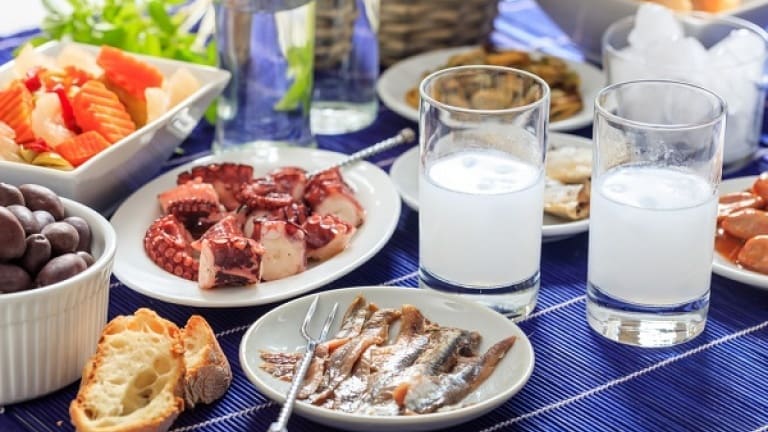Ouzo: all you need to know about the mythical Greek aniseed liqueur

Ouzo, a cousin of sambuca and pastis, is a traditional Greek liqueur flavored with anise and fennel. You will find a nice glass of frozen ouzo ready to welcome you on every Greek table: it is the classic aperitif that you can drink while accompanying it with the classic mezedes, the Greek appetizers.
History of ouzo
Ouzo is an old liqueur that has been made in Greece for hundreds of years. In fact, legend has it that the monks of Mount Athos were the first people to try distilling it.
But you shouldn’t be surprised, because, as you know, all of the knowledge and techniques were kept and tested by the monks, who were the real keepers of culture and the link between the Middle Ages and the Renaissance.
And the monks of Mount Athos seem to have found the formula for making ouzo, starting from a simple distillation that was intended to create medicinal elixirs.
But the same goes for gin, which was invented by the monks of the Amalfi Coast while trying to produce juniper oil to treat pain and arthritis.
Where ouzo is produced
Over the years, the method has been improved, and we’ve gone from making a distillate at home using rough methods to making a product that is sold all over Greece and Cyprus, the only two countries that can claim the PDO.
Everyone can produce ouzo, but only they can call it that, exactly like grappa in Italy or cognac in France.
And since we are talking about grappa, ouzo derives above all from Tsipouro, the Greek brandy (wannabe grappa) produced from marc or wine, which is later (possibly) flavored with anise.
How ouzo is made
The main difference is that Tsipouro is flavored brandy and Ouzo is made like sambuca, so it is a flavored and sweetened liqueur.
Basically, take alcohol at 96 degrees, infuse the anise, fennel, cardamom, cinnamon, and a thousand other spices, flowers, and other botanicals in it, and then let the ingredients soak.
So, the essential oils of the plants are mixed into the ethyl alcohol, which is then distilled for the first time to make a very strong and raw brandy.
The aroma of the ouzo is then defined by a second distillation.
The heads and tails are thrown away and added to the next distillation, while the heart can be distilled a third time or sugar can be added and the bottle sealed.
The process is always the same: with the distillation, the alcohol is evaporated at 75 degrees, the vapors are collected in a coil cooled with water, and based on how much the master distiller chooses to keep or discard the taste, ouzo is created.
It’s the same method used to make triple sec, gin, or sambuca: nothing new under the Aegean sun, but the result is a liqueur that knows how to liven up dinners and evenings, even though ouzo-based cocktails are truly scarce.
Alcoholic degree of ouzo
By law, the minimum is 37.5 degrees, and it reaches up to 50 degrees, but usually, we are around 40. It does not want to be a battle liqueur but rather a delicate and fragrant digestive aperitif.
How to serve Greek ouzo
If you serve it as an aperitif with the classic meze, it should be served at 8 degrees, frozen. Pour it into small shot glasses and do not add water. Just like French pastis or Italian sambuca, if you add 1 tablespoon of water to the ouzo, it becomes opalescent.
It’s not magic; it’s just the terpenes that get loose from the alcohol as it gets watered down. By adding water, the terpenes (light and very volatile substances) rise to the surface of the liqueur, freeing themselves from the alcohol, but at the same time bringing with them the most floral and delicate aromas.
If you want to enhance the aromas of ouzo, add a little water, close your eyes, and smell. It is also excellent when served as a digestive, but never serve it with ice; otherwise, you would kill aromas and flavors by numbing your tongue.
Cost of Greek ouzo
The best bottles are hard to find outside of Greece because they are only made in small quantities and sold mostly in Greece. There are the usual big brands to choose from, starting at 12 euros and going up to 25 or 30 euros.

